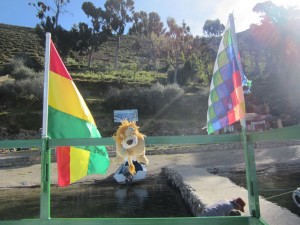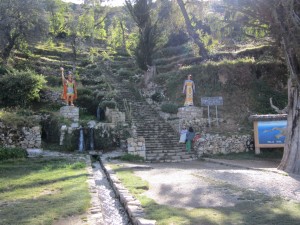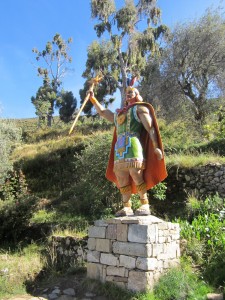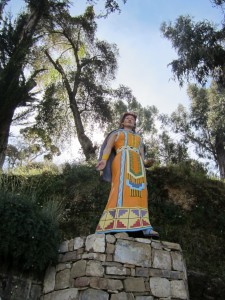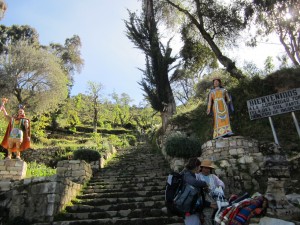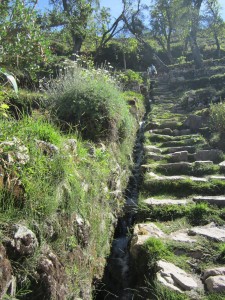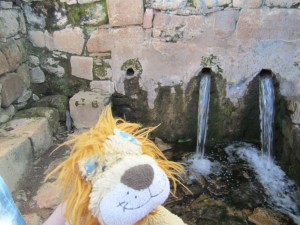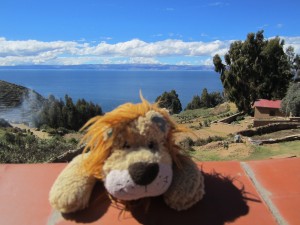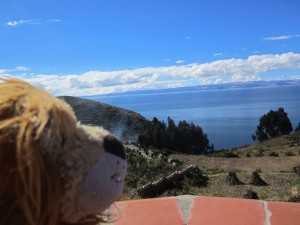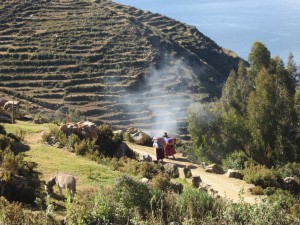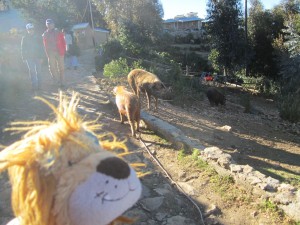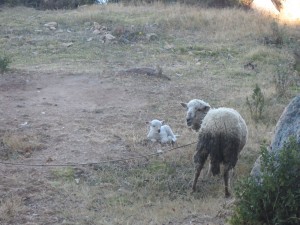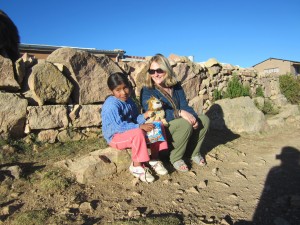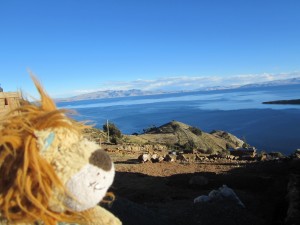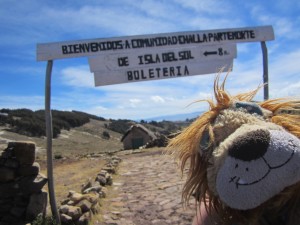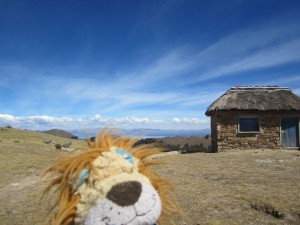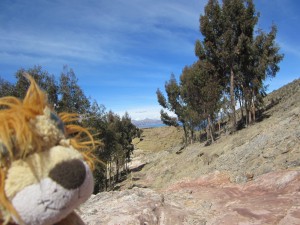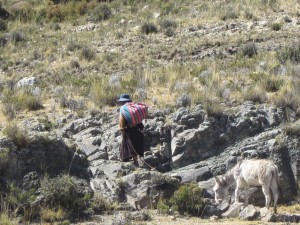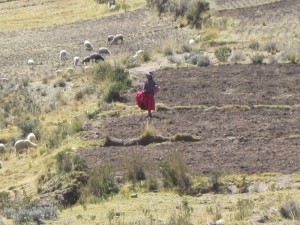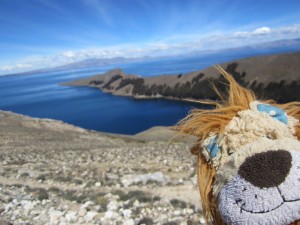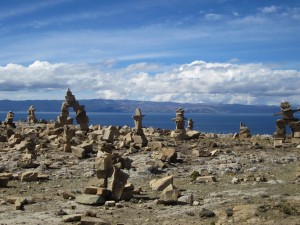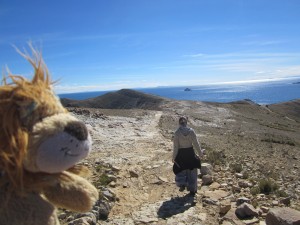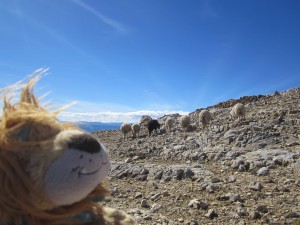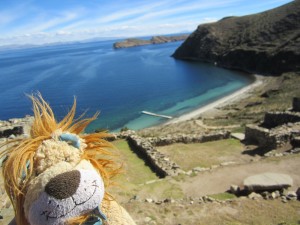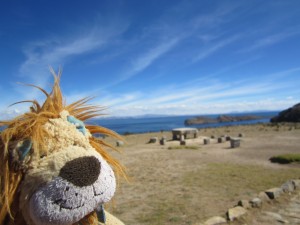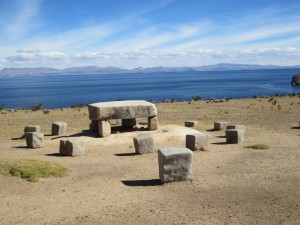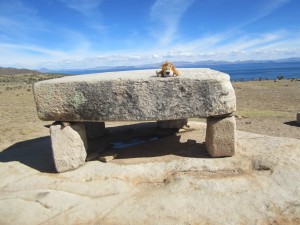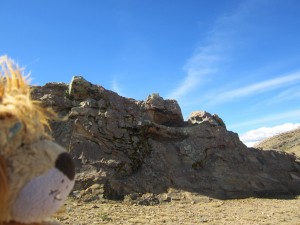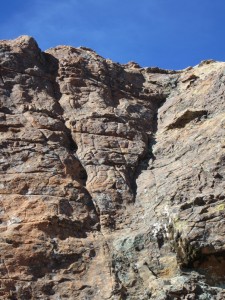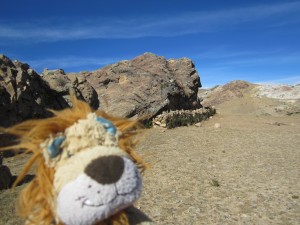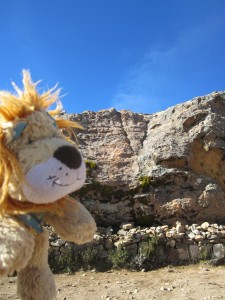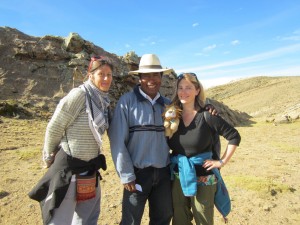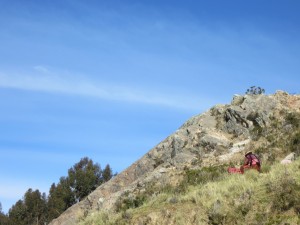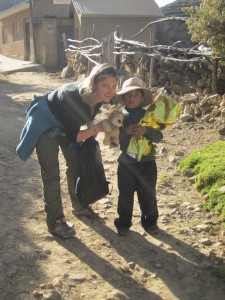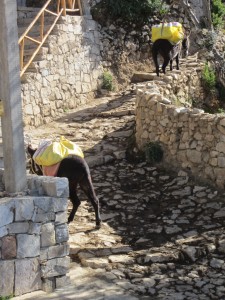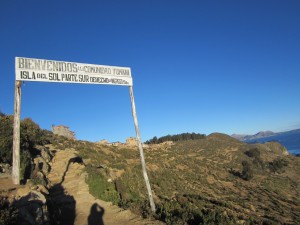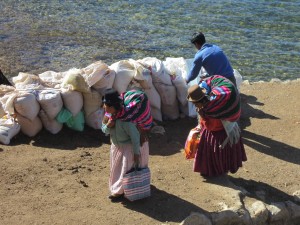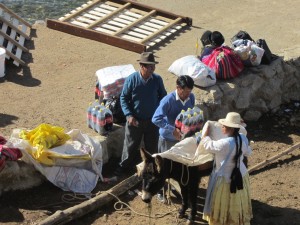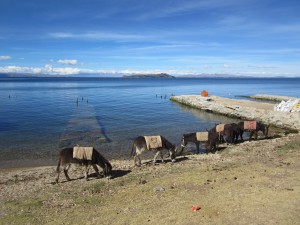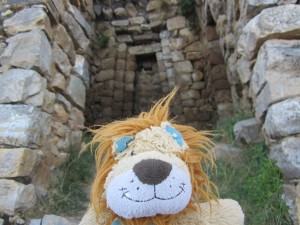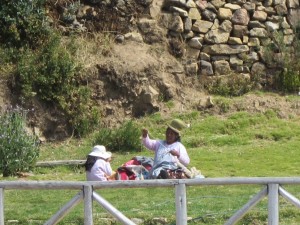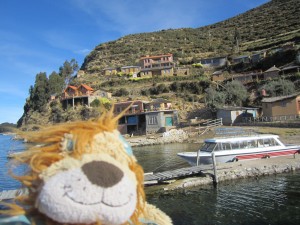About an hour’s ride away from La Isla de la Luna is la Isla del Sol (the Sun Island), the biggest of Lake Titicaca’s islands with approximately 2000 inhabitants. (Many of which are of the traditional Aymara communities. Lewis the Lion will talk more about the Aymara language in his Lewis loves languages section).
The pre-Inca culture, the Andeans believed that the Sun Island was the birthplace of the sun set in the middle of the sacred Titicaca Lake or Mamacocha as they called it. The island was also believed to be the birthplace of the Inca dynasty.
Consequently, like the city of Copacabana, it has seen many pilgrims and visitors over the centuries.
When Lewis the Lion arrived on L’Isla del Sol there was a $5 Bolivianos entrance charge on the southern part of the island (and then a $15 charge for the northern part of the island later on).
In the sunshine he was greeted by statues of the Inca king and queen and were then swarmed by a group of local children speaking in English who wanted to show him different hostels and restaurants on the island. Lewis the Lion was very impressed by their level of English and wondered if children in the UK would be able to converse with visitors in such a way? The children were very insistent as Helen, Lewis the Lion and Aurelie trudged up the sacred stairway, l’Escalera de Inca, with their heavy mochilas (rucksacks) past the three springs believed to have magical powers.
These three springs also represented the three principals of the Inca culture: don’t lie, don’t steal and don’t be lazy.
Thanks to Aurelie, the friends eventually found a brilliant hostel with a terrace looking out over the picturesque lake for only $30 bolivianos a night!
This was the cheapest hotel that Lewis the Lion had ever stayed in in his little life! However, apart from the view, he could understand why. It was quite basic with a bucket of water to flush the toilet, a tepid shower at best and no central heating, just lots of heavy blankets.
Nonetheless, the view from the terrace and outside restaurant was simply wonderful and Lewis the Lion felt a deep sense of relaxation. He really felt like he was on holiday now!
He thought that it was simply idyllic to see people farming on the terraces below, using traditional methods.
After all, this island has no cars and so the usual way of moving goods is by donkey as you can see in these pictures. However, he also saw llamas, sheep, bulls and pigs being ushered along the island’s pathways over the coming days, generally by shepherdesses and children.
From Lewis the Lion’s hotel, Las Islas, he could also hear a reoccurring refrain from the grounds of the village church as the village band were practising for their patron saint’s annual feast day. Lewis the Lion felt incredibly lucky to have ended up visiting this island at this particular time, the feast of St Anthony of Padua. (He will share more about his experiences on the feast day in his next blog).
Lewis the Lion then went on a little exploration of the island but he didn’t want to go too far as it was already evening time and the island didn’t have street lights.
However, he enjoyed greeting some of the animals (such as sheep and pigs),
and seeing them being moved around the island by skilful farmers.
He also met a little girl near some friendly donkeys who told him that she would never want to go to England because it was ugly! Lewis the Lion told her that there are many beautiful parts of England too but could understand why she would think that, coming from such an idyllic island!
The next day, Lewis the Lion’s curious nature got the better of him and he went on a very long walk right around the island (a 19-kilometre round trip).
He was following the “Sacred Route of the Eternity of the Sun” of the Incas that would lead him to some Inca ruins, a sacrificial altar and a sacred rock. (This path is called “La Ruta Sagrada de la Eternidad del Sol” in Spanish and “Willka Thaki” in Aymara). The scenery along the way was simply magnificent as you can see in some of these photos.
He especially loved seeing the stepped terraces and the farmers in the fields, all whilst being mesmerised by the beauty of Lake Titicaca surrounding them.
The walk to the Inca ruins was just magnificent and Lewis enjoyed walking along with Helen and Aurelie and watching the scenery change and animals move quickly around them.
When Lewis the Lion reached the northern-most point of the island, Chinkana, he discovered a ruined Inca complex of interlinked rooms and open squares, all overlooking the magnificent Lake Titicaca.
He thought that the Incas must have been really smart to have chosen this spot as the centre point for their beliefs, it was just so beautiful and tranquil!
Being an ever-daring lion, Lewis even took a sneaky sit-down on the sacrificial altar but he hoped that there had been no human sacrifices here!
Just then, Aurelie and Helen started to chat to a local Aymara guide called Jorge. He pointed out the various shapes in the sacred rock (“la Roca Sagrada” in Spanish),
such as the face of the creator god Viracocha (who is said to have created the sun and moon)
and the puma (an animal of special importance in the Inca culture).
The sacred rock was said to give off a strong energy and have a strong magnetic force.
Jorge then went on to teach Lewis the Lion the ‘magic words’ in Aymara by writing the words in the sand! You can learn these words in the Lewis Loves Languages section.
As the friends then set to return to the south of the island, they met local people and children dressed in colourful clothes.
Often these people wanted money for you to take a photo of them: they were obviously used to having tourists on the island! The path rose and fell, passing picturesque bays, villages and sandy stretches. However, you always had to watch were you were walking on the rocky stones as there was a strong likelihood that donkeys had been there just before, leaving their droppings all over the place!
The journey home became a bit of a race as the friends had taken such a leisurely pace to get to the ruins, it was now getting later on into the afternoon and they hadn’t got any torches or flashlights with them, a must on an island without street lamps. Some villagers told the visitors that it would take them 3 hours to get back to Yumani where they started from.
Oh dear! They therefore dug in deep, even though they were tired and quickened their speed and unbelievably got back to Yumani just as the sun was setting in less than an hour and a half. Phew! They’d made it.
Lewis the Lion now felt extremely hungry and so enjoyed a pizza in a restaurant with Helen and Aurelie. For the rest of his stay on this delightful island he would enjoy the village festivities which you can find out about in his next blog.
However, here are some more photos of what Lewis the Lion saw as he was leaving la Isla del Sol.
He thought that the local people seemed to live a humble, if not hard existence on the island without modern technologies around them. Could he ever imagine living such a basic existence? Could you? On the other hand, he certainly could understand why visitors would feel relaxed and rejuvenated after visiting this island.
He wondered if perhaps the sacred rock had anything to do with it?! What do you think?
Lewis the Lion will learn more about the Incas and their empire during his stay in Bolivia and Peru but if you would like to do some of your own research about the Incredible Incas, click on the link.

